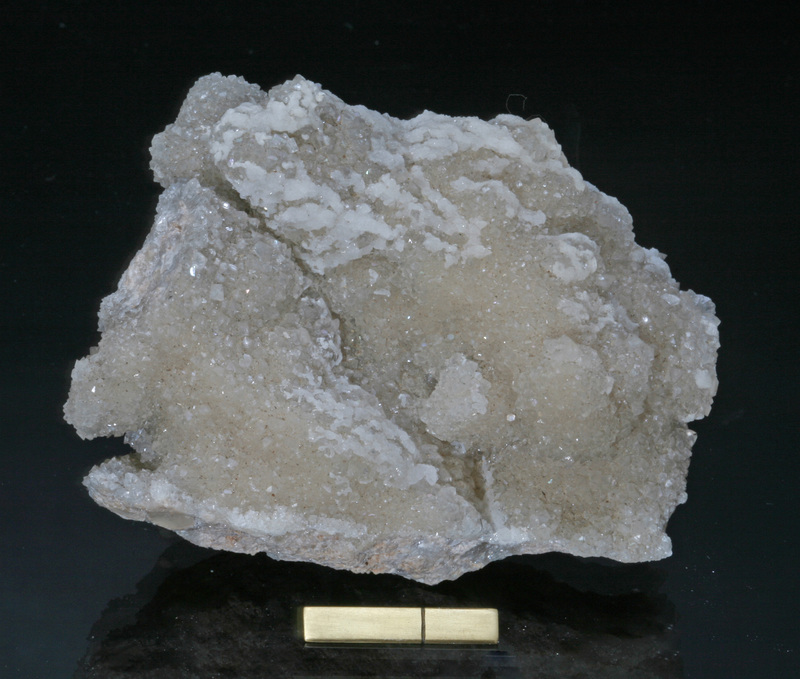Tunellite
A valid IMA mineral species
This page is currently not sponsored. Click here to sponsor this page.
About Tunellite
Formula:
SrB6O9(OH)2 · 3H2O
Colour:
Colourless, grayish white
Lustre:
Sub-Vitreous, Pearly
Hardness:
2½
Specific Gravity:
2.40
Crystal System:
Monoclinic
Name:
Named by R.C. Erd, V. Morgan, and J.R. Clark in 1961 in honor of George Gerard Tunell, Jr. (4 April 1900, Chicago, Illinois, USA - 4 July 1996, Montecito, California, USA), professor of geochemistry, University of California. President of the Mineralogical Society of America (1950) and Roebling Medal recipient in 1973. He made major advances in X-ray crystallography, physical chemistry, and thermodynamic analysis of minerals, especially metallic ores. The name is pronounced tŭn nĕl' īt.
This page provides mineralogical data about Tunellite.
Unique Identifiers
Mindat ID:
4050
Long-form identifier:
mindat:1:1:4050:7
GUID
(UUID V4):
(UUID V4):
2a258ab6-cf35-4a10-930b-f1d116d001a1
IMA Classification of Tunellite
Approved
First published:
1961
Classification of Tunellite
6.FC.05
6 : BORATES
F : Hexaborates
C : Phyllo-hexaborates
6 : BORATES
F : Hexaborates
C : Phyllo-hexaborates
26.6.6.2
26 : HYDRATED BORATES CONTAINING HYDROXYL OR HALOGEN
6 : Hexaborates
26 : HYDRATED BORATES CONTAINING HYDROXYL OR HALOGEN
6 : Hexaborates
9.3.31
9 : Borates
3 : Borates of Ca and Sr
9 : Borates
3 : Borates of Ca and Sr
Mineral Symbols
As of 2021 there are now IMA–CNMNC approved mineral symbols (abbreviations) for each mineral species, useful for tables and diagrams.
| Symbol | Source | Reference |
|---|---|---|
| Tnl | IMA–CNMNC | Warr, L.N. (2021). IMA–CNMNC approved mineral symbols. Mineralogical Magazine, 85(3), 291-320. doi:10.1180/mgm.2021.43 |
Physical Properties of Tunellite
Sub-Vitreous, Pearly
Transparency:
Transparent
Comment:
Pearly on cleavages
Colour:
Colourless, grayish white
Streak:
White
Hardness:
2½ on Mohs scale
Tenacity:
Flexible
Cleavage:
Perfect
Perfect on {100}
Distinct on {001}
Perfect on {100}
Distinct on {001}
Density:
2.40(1) g/cm3 (Measured) 2.391 g/cm3 (Calculated)
Optical Data of Tunellite
Type:
Biaxial (+)
RI values:
nα = 1.519 nβ = 1.534 nγ = 1.569
2V:
Calculated: 68°
Max Birefringence:
δ = 0.050

Image shows birefringence interference colour range (at 30µm thickness)
and does not take into account mineral colouration.
and does not take into account mineral colouration.
Surface Relief:
Low
Dispersion:
r > v weak
Optical Extinction:
Y = b; X ∧ a = 29°; Z ∧ c = –5°.
Chemistry of Tunellite
Mindat Formula:
SrB6O9(OH)2 · 3H2O
Elements listed:
Crystallography of Tunellite
Crystal System:
Monoclinic
Class (H-M):
2/m - Prismatic
Space Group:
P21/b
Cell Parameters:
a = 14.415(3) Å, b = 8.213(1) Å, c = 9.951(2) Å
β = 114.05°
β = 114.05°
Ratio:
a:b:c = 1.755 : 1 : 1.212
Unit Cell V:
1,075.83 ų (Calculated from Unit Cell)
Z:
4
Morphology:
Crystals to 10 cm elongated on [001]. Flattened tabular with dominant {100}. Compact fine grained nodules. Forms include {100}, {001}, {110}, {011}, and {111}.
Crystal Structure
Load
Unit Cell | Unit Cell Packed
2x2x2 | 3x3x3 | 4x4x4
Unit Cell | Unit Cell Packed
2x2x2 | 3x3x3 | 4x4x4
Show
Big Balls | Small Balls | Just Balls | Spacefill
Polyhedra Off | Si Polyhedra | All Polyhedra
Remove metal-metal sticks
Big Balls | Small Balls | Just Balls | Spacefill
Polyhedra Off | Si Polyhedra | All Polyhedra
Remove metal-metal sticks
Display Options
Black Background | White Background
Perspective On | Perspective Off
2D | Stereo | Red-Blue | Red-Cyan
Black Background | White Background
Perspective On | Perspective Off
2D | Stereo | Red-Blue | Red-Cyan
View
CIF File Best | x | y | z | a | b | c
CIF File Best | x | y | z | a | b | c
Rotation
Stop | Start
Stop | Start
Labels
Console Off | On | Grey | Yellow
Console Off | On | Grey | Yellow
Data courtesy of the American Mineralogist Crystal Structure Database. Click on an AMCSD ID to view structure
| ID | Species | Reference | Link | Year | Locality | Pressure (GPa) | Temp (K) |
|---|---|---|---|---|---|---|---|
| 0000129 | Tunellite | Clark J R (1964) The crystal structure of tunellite, SrB6O9(OH)2.3H2O American Mineralogist 49 1549-1568 |  | 1964 | Jenifer mine, Kramer borate district, California, USA | 0 | 293 |
| 0005416 | Tunellite | Burns P C, Hawthorne F C (1994) Hydrogen bonding in tunellite The Canadian Mineralogist 32 895-902 |  | 1994 | 0 | 293 | |
| 0018902 | Tunellite | Clark J R (1963) Boron-oxygen polyanion in the crystal structure of tunellite Science 141 1178-1179 | 1963 | Jenifer mine, Kramer borate district, California, USA | 0 | 293 |
CIF Raw Data - click here to close
X-Ray Powder Diffraction
Image Loading
Radiation - Copper Kα
Data courtesy of RRUFF project at University of Arizona, used with permission.
Powder Diffraction Data:
| d-spacing | Intensity |
|---|---|
| 6.57 Å | (100) |
| 4.525 Å | (11) |
| 3.867 Å | (9) |
| 5.138 Å | (8) |
| 3.592 Å | (8) |
| 2.503 Å | (8) |
| 6.78 Å | (7) |
Comments:
Furnace Creek district, California, USA.
Geological Environment
Paragenetic Mode(s):
| Paragenetic Mode | Earliest Age (Ga) |
|---|---|
| Near-surface Processes | |
| 25 : Evaporites (prebiotic) |
Geological Setting:
Secondary mineral in borate deposits
Type Occurrence of Tunellite
General Appearance of Type Material:
White compact fine-grained nodules. Also as individual long prismatic crystals up to 1.5 cm in length and equant crystals up to 1 cm in diameter.
Place of Conservation of Type Material:
National Museum of Natural History, Washington, D.C., USA, number 123928.
Geological Setting of Type Material:
A secondary mineral in a borate deposit.
Associated Minerals at Type Locality:
Other Language Names for Tunellite
Common Associates
Associated Minerals Based on Photo Data:
| 21 photos of Tunellite associated with Ulexite | NaCa[B5O6(OH)6] · 5H2O |
| 8 photos of Tunellite associated with Hydroboracite | CaMg[B3O4(OH)3]2 · 3H2O |
| 3 photos of Tunellite associated with Colemanite | Ca[B3O4(OH)3] · H2O |
| 3 photos of Tunellite associated with Inderite | MgB3O3(OH)5 · 5H2O |
| 1 photo of Tunellite associated with Pararealgar | As4S4 |
Related Minerals - Strunz-mindat Grouping
| 6.FC.05 | Nobleite | CaB6O9(OH)2 · 3H2O |
| 6.FC.10 | Strontioborite | Sr[B8O11(OH)4] |
| 6.FC.15 | Ginorite | Ca2B14O20(OH)6 · 5H2O |
| 6.FC.15 | Strontioginorite | CaSrB14O20(OH)6 · 5H2O |
| 6.FC.20 | Fabianite | CaB3O5OH |
Other Information
Notes:
Soluble in cold dilute acid or strong alkaline solutions. Unaffected by glycerol or methanol. In H2SO4, a coating of SrSO4 inhibits further dissolution.
Heated in a closed tube, tunellite exfoliates perpendicular to the cleavage, turns silvery white (resembling muscovite), then turns chalky white. The water driven off has a pH of 4.
Heated in a closed tube, tunellite exfoliates perpendicular to the cleavage, turns silvery white (resembling muscovite), then turns chalky white. The water driven off has a pH of 4.
Health Risks:
No information on health risks for this material has been entered into the database. You should always treat mineral specimens with care.
Internet Links for Tunellite
mindat.org URL:
https://www.mindat.org/min-4050.html
Please feel free to link to this page.
Please feel free to link to this page.
Search Engines:
External Links:
Mineral Dealers:
References for Tunellite
Reference List:
Clark, J. R. (1963) Boron-Oxygen Polyanion in the Crystal Structure of Tunellite. Science, 141 (3586). 1178-1179 doi:10.1126/science.141.3586.1178
Clark, Joan R. (1964) The crystal structure of tunellite, SrB6O9(OH)2·3H2O. American Mineralogist, 49 (11-12) 1549-1568
IMA (1967) International Mineralogical Association: Commission on New Minerals and Mineral Names. Mineralogical Magazine and Journal of the Mineralogical Society, 36 (277) 131-136 doi:10.1180/minmag.1967.036.277.20
Localities for Tunellite
Locality List
 - This locality has map coordinates listed.
- This locality has map coordinates listed.
 - This locality has estimated coordinates.
ⓘ - Click for references and further information on this occurrence.
? - Indicates mineral may be doubtful at this locality.
- This locality has estimated coordinates.
ⓘ - Click for references and further information on this occurrence.
? - Indicates mineral may be doubtful at this locality.
 - Good crystals or important locality for species.
- Good crystals or important locality for species.
 - World class for species or very significant.
(TL) - Type Locality for a valid mineral species.
(FRL) - First Recorded Locality for everything else (eg varieties).
- World class for species or very significant.
(TL) - Type Locality for a valid mineral species.
(FRL) - First Recorded Locality for everything else (eg varieties).
All localities listed without proper references should be considered as questionable.
Turkey | |
| Helvaci et al. (1991) |
| Helvaci +2 other references | |
| Helvaci et al. (1991) | |
| Helvaci et al. (1991) | |
| Baysal (1972) +1 other reference |
| J. García-Veigas et al. (2010) +1 other reference |
| American Mineralogist +4 other references |
USA | |
| Erd et al. (1961) +1 other reference |
| Collected it in the mine-Rock Currier +3 other references |
| www.mineralsocal.org |
| Cal Div of Mines & Geology "Mineral ... | |
| Erd et al. (1961) +1 other reference |
| Erd et al. (1961) +2 other references | |
| Van Nostrand Reinholt Press: 241 +2 other references | |
| Van Nostrand Reinholt Press: 255. +2 other references |
| USGS |
Quick NavTopAbout TunelliteUnique IdentifiersIMA Classification Classification Mineral SymbolsPhysical Properties Optical Data Chemistry Crystallography Crystal StructureX-Ray Powder DiffractionGeological EnvironmentType Occurrence Other LanguagesCommon AssociatesStrunz-MindatOther InformationInternet Links References Localities Locality List






 symbol to view information about a locality.
The
symbol to view information about a locality.
The 



Rio Tinto Borax open pit, Rio Tinto Borax Mine, Kramer Borate deposit, Boron, Kern County, California, USA